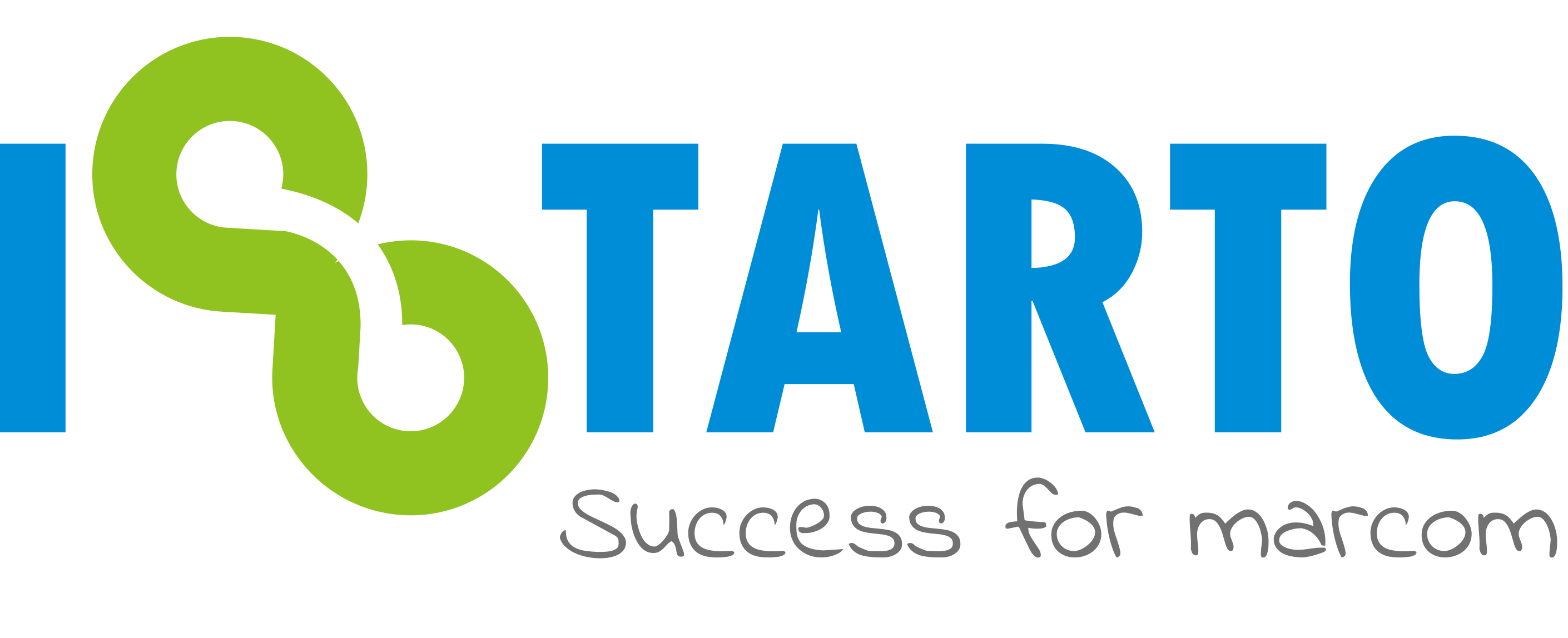Imagine, if you will, a country of more than 1.3 billion people with no access to Facebook, Instagram, or Twitter. Now imagine that more than half of those people—846 million, to be precise—are using one online social service to chat and share with friends, read news, play games, track their fitness goals, make voice and video calls, shop online, and even pay for lunch.
This is not a fantasy. The country is China, and the service is WeChat. With an average of 570 million users logging into WeChat every single day and using the service’s multiple functions all day long (60 percent of users open the app more than 10 times per day), WeChat marketing offers a powerful way to connect with consumers.
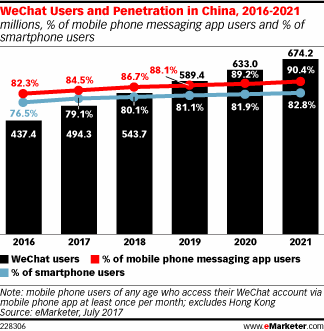
Image via eMarketer.
What is WeChat?
WeChat is, at its core, a messaging app, but that is really only a fraction of what the service can do. If also offers more traditional social networking functions like video and picture sharing, games, stickers, and the ability to share and connect with friends through WeChat Moments.

But it’s also a social commerce platform, incorporating WeChat Stores for online shopping and WeChat Pay and WeChat Wallet for payments to both online and brick and mortar vendors. It even offers professional functions like expense tracking. It can be used to book a taxi, a flight, or a doctor’s appointment. It’s like Facebook, Skype, Slack, Amazon, PayPal, and Apple Wallet all rolled up into one. No wonder it’s China’s most popular mobile app.
Here, though, it’s important to share a caveat about WeChat marketing: WeChat is available worldwide, but the vast majority of users—up to 90 percent by some estimates—are in China. And in order to market to Mainland Chinese WeChat users, you need to have a business presence registered in Mainland China.
Businesses based in the United States, South Africa, Hong Kong, India, Indonesia, Macau, Malaysia, Taiwan, and Thailand can use a WeChat business account to market to WeChat’s estimated 100 million international users (including Chinese users in Hong Kong, Taiwan, and Macau), but you’ll be missing out on the massive Mainland Chinese user base. WeChat features also vary by region.
That said, WeChat has been making a push for international expansion, especially in Africa. It’s Africa’s fastest growing social communication platform, and is estimated to have about 5 million users in South Africa alone (compare that to the 13 million South Africans using Facebook). So you shouldn’t overlook the WeChat marketing potential in the rest of the world, even if the numbers are not as tantalizing as that huge Chinese figure.
How to use WeChat for business
Let’s start by looking at the three types of WeChat business account: subscription accounts, service accounts, and enterprise accounts. They all fall under the category of Official Accounts, which are available to celebrities, media, government organizations, and businesses. Subscription accounts offer more messaging, but service accounts offer more robust functionality. Enterprise accounts are primarily for organizational management and are not of primary interest to marketers.
- Subscription accounts: Allow one broadcast message per day to subscribers; messages appear in the subscription accounts folder.
- Service accounts: Allow up to four broadcast messages per month; messages appear in the friend session list. Verified accounts have access to nine advanced APIs and can apply for WeChat Pay.
- Enterprise accounts: Offer messaging and business tools but are only available in Mainland China.
How to apply for a WeChat Official Account
These steps apply to the International-Market Platform. If you have a business based in China, you can access the Chinese market by using the Mainland China-Market Platform.
- Gather all the required information, including your business license and personal ID. It’s a good idea to check the full list of required materials before you begin.
- Go to the Official Account registration page and submit your application.
- It takes two weeks for your account to be reviewed. While you wait, you can check your application status using your application email and application number.
How to set up your WeChat business account profile
Once your account is approved, you gain access to the Official Account Admin Platform, the console from which you can interact with WeChat users, run WeChat marketing campaigns, and track your results.
To set up your profile, scroll down to the bottom of the page to access the Settings tab from the left-hand menu. On this screen, you can choose your profile picture, create your QR code, select your region, and add your company description (which WeChat calls an ‘introduction’).

Keep in mind that you can change your profile picture and introduction a maximum of five times per month, so you’ll want to make sure you have your text and photo properly edited before you save them in the system.
How to use WeChat for marketing
WeChat’s many functions give brands multiple ways of interacting and engaging with customers. Here are some examples of how to take advantage of WeChat’s functionality based on brands that are already using WeChat marketing to great effect.
Location-based marketing
Since WeChat Official Service Accounts can detect user location, they’re a great fit for location-based marketing.
OrderIn, a food delivery service company in South Africa, uses WeChat to show customers a list of local restaurants based on their current location or a specific street address. Customers can browse menus, place their order, and even pay for the food, all within the WeChat app. Once the restaurant receives the order, staff confirm through the WeChat app when the customer should expect the delivery. It’s a seamless ordering experience that never requires customers to pick up the phone or get out their cash or credit card.
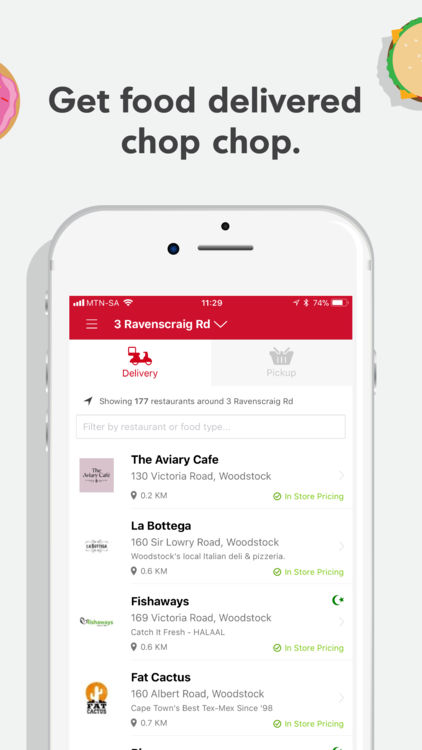
Personalized content curation and content marketing
Big-name publications like The New York Times, the Wall Street Journal, Huffington Post, and Vogue are creating WeChat Official Accounts to push daily content to WeChat subscribers.
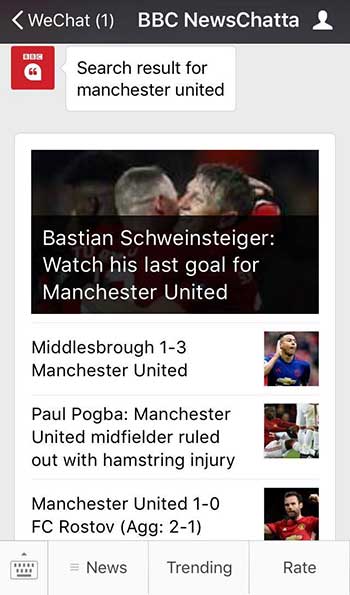
But BuzzFeed, that most viral of media outlets, is using one WeChat feature in a unique way to allow readers to self-select the content they receive. BuzzFeed followers automatically receive one daily content item, but they can also use WeChat’s chat functionality to access custom content based on a list of keywords that trigger auto-replies.
This being BuzzFeed, the list of keywords contains words like “fail,” “win,” and “cute,” making it a good fit for the BuzzFeed audience and a great way for users to uncover sharable content that they can then pass on to friends through chats or WeChat Moments.
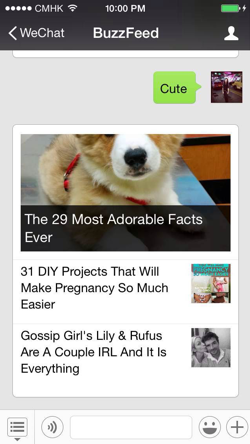
And content providers are not the only companies taking advantage of this feature. Yoox, an online fashion and design store, uses the same functionality to allow users to access content like videos, recipes, and gift guides, as well as exclusive products.

Customer engagement
In a Valentine’s Day campaign, Tiffany & Co. used WeChat posts to ask followers about the meaning of love by sharing their take on the phrase “Love Is…” The campaign encouraged user engagement with the Tiffany brand while positioning Tiffany jewelry as the appropriate gift for the ones you love. While they were already thinking about love, WeChatters could use a tool within the Tiffany & Co. WeChat Official Account to find the ideal engagement ring, then use the store locator to see where they could go to buy it.
Even if they weren’t ready to head to the store, WeChatters could share animated GIFs from the campaign, amplifying Tiffany’s creative across their networks.
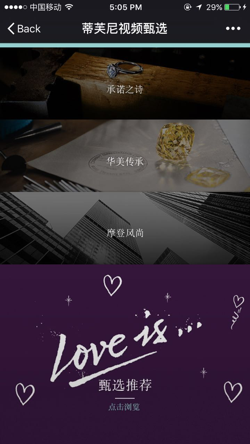
Coca-Cola Hong Kong, meanwhile, used mini-games within the WeChat interface to encourage customer engagement. WeChatters who answered trivia questions and played the games could receive offers for 7-Eleven stores, and were entered into a draw to win a 65-inch TV.

Get creative with QR codes
WeChat automatically creates a QR code for each Official Account. The app also includes a QR code scanner, which allows brands to get creative with QR codes both within and outside of the app.
In Korea, discount chain store E-Mart created a three-dimensional sculpture that showed a QR code in shadow when the light hit it at just the right angle. Since lunchtime is a key time for online shopping, that’s when the QR code would appear. Scanning the code took users to the E-Mart WeChat Official Account, increasing both followers and sales.

But perhaps the most exciting use of QR codes is by Stuff Magazine in South Africa. Products in the magazine are matched with QR codes. Scanning those codes using WeChat takes readers directly to their WeChat Wallet, where they can order the product with a couple of clicks and at a discounted price.
Now that you know more about WeChat marketing, it’s time to think about how to incorporate this robust social channel into your overall social media marketing strategy. How will you put the app’s unique combination of features to work for your business?
